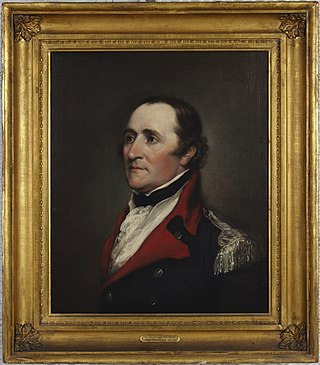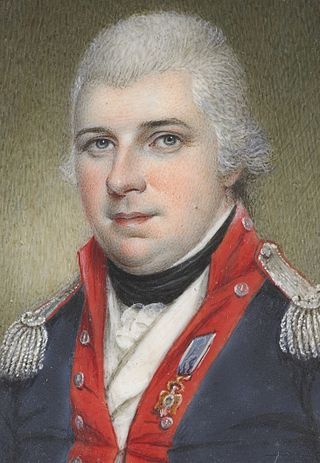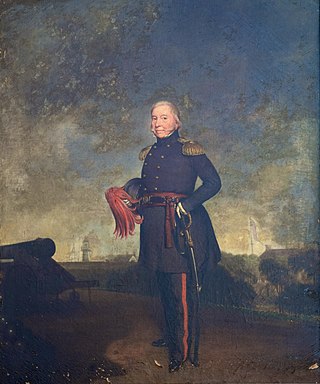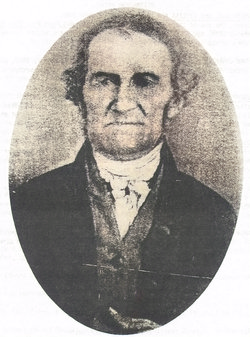
Edward Hand was an Irish soldier, physician, and politician who served in the Continental Army during the American Revolutionary War, rising to the rank of general, and later was a member of several Pennsylvania governmental bodies.

Richard Butler was an officer in the Continental Army during the American Revolutionary War who was later killed while he was fighting Native Americans in the United States in a battle that is known as St. Clair's Defeat.

Brigadier-General Sir John Johnson, 2nd Baronet was an American-born military officer, magistrate, landowner in the British Indian Department who fought as a Loyalist during the American Revolutionary War. He was the son of Sir William Johnson, 1st Baronet, who was the first British Superintendent of Indian Affairs. He inherited his father's baronetcy and estate in 1774.
Zebulon Butler was an American military officer and politician from Connecticut who served with the Continental Army during the Revolutionary War. He represented the Wyoming Valley in the Connecticut Assembly. At the time, the territory was claimed both by Connecticut and by Pennsylvania, and was nominally under the former's jurisdiction.

Ebenezer Huntington was an officer in the Continental Army during the American Revolutionary War, and afterwards United States Representative from Connecticut.
William Stacy was an officer of the Continental Army during the American Revolutionary War, and a pioneer to the Ohio Country. Published histories describe Colonel William Stacy's involvement in a variety of events during the war, such as rallying the militia on a village common in Massachusetts, participating in the Siege of Boston, being captured by Loyalists and American Indians at the Cherry Valley massacre, narrowly escaping a death by burning at the stake, General George Washington's efforts to obtain Stacy's release from captivity, and Washington's gift of a gold snuff box to Stacy at the end of the war.

Hugh Brady was an American general from Pennsylvania. He served in the Northwest Indian War under General Anthony Wayne, and during the War of 1812. Following the War of 1812, Brady remained in the military, eventually rising to the rank of major general and taking command of the garrison at Detroit. He also marginally participated in the 1832 Black Hawk War. Hugh Brady died an accidental death in 1851 when he was thrown from a horse-drawn carriage.
Piers Butler, 3rd Viscount Galmoye, otherwise Viscount Galmoy, was an Anglo-Irish nobleman. He was descended from the 10th Earl of Ormond. He was the son of Edward Butler, 2nd Viscount Galmoye and Eleanor White.

Thomas Humphrey Cushing was an officer in the Continental Army, and later the United States Army. A veteran of the American Revolutionary War and the War of 1812, he attained the rank of brigadier general. He later served as collector of customs for the Port of New London, Connecticut.

Edward Butler was an officer in the United States Army who served as acting Adjutant General and acting Inspector General of the U.S. Army from 1793 to 1794 and from 1796 to 1797.
General Sir William Stewart, was a Scottish-born soldier, Commander-in-chief of Queen Anne's Forces in Ireland, Member of Parliament for County Waterford and a Privy Councillor. He was a benefactor of Hanover Square, London, donating the land and laying the first stone of St George's, Hanover Square.

John Baptiste de Barth Walbach was an Alsatian baron who fought in the French Revolutionary Wars, and was one of the few foreign-born senior officers in the United States Army prior to the American Civil War, attaining the rank of brevet brigadier general by brevet.

Ebenezer Sproat, surname also spelled Sprout, was an officer of the Continental Army during the American Revolutionary War, a pioneer to the Ohio Country, and one of the founders of Marietta, Ohio, the first permanent American settlement in the Northwest Territory. He served throughout the entire American war of independence, from April 1775 through November 1783, achieving the rank of colonel. After the war, he was a pioneer and surveyor in the Northwest Territory, and became a leader of the militia at Marietta during the Northwest Indian War. He was the first sheriff in the Northwest Territory and Ohio, serving fourteen years as sheriff of Washington County, the oldest county in Ohio.

General Sir Richard Chambré Hayes Taylor was a senior British Army officer who served in the Second Anglo-Burmese War, the Crimean War and the Indian Mutiny. Joining the General Staff in 1860, he was the British Army's Inspector General of Recruiting, then Deputy Adjutant-General to the Forces, briefly Adjutant-General, and finally for three years Governor of the Royal Military College, Sandhurst. He was also Colonel of the Queen's Own Cameron Highlanders and the East Surrey Regiment.
General John Despard (1745–1829) was an Irish-born soldier who had a long and distinguished career in the British Army and as a colonial administrator. He was the brother of Edward Despard, also a soldier, who was executed in 1803 for his part in the Despard Plot.
Thomas Butler (1748–1805) was a Continental Army officer from Pennsylvania during the American Revolution. He was commissioned in the United States Army after the Revolution and rose to the rank of colonel.

Francis Tennille, was a Lieutenant Colonel during the American Revolutionary War who fought for the American Continental Army.

John Bull politician, military officer, statesman, and planter. Initially, his military career started under John Forbes in the Forbes Expedition during the 1750s. During the American Revolution, he was a delegate in the Pennsylvania Provincial Conference which declared Pennsylvania independent from the British Colonies. Benjamin Franklin and Bull sat on many committees together.. Bull was a very active participant in many different roles during the revolution. He was mainly in charge of the defenses of Fort Billingsport. He held the rank of Colonel in Pennsylvania's 2nd Regiment and eventually rose to the rank of Adjutant General of the Pennsylvania Militia by the Pennsylvania Supreme Executive Council in defense of Philadelphia during the Philadelphia campaign.

The Royal Irish Regiment of Foot Guards, or "His Majesty’s Regiment of Guards in Ireland", was a regiment of foot guards first raised in 1662 for service in Ireland. Part of the Irish Army of Charles II, it was initially garrisoned around Dublin.












